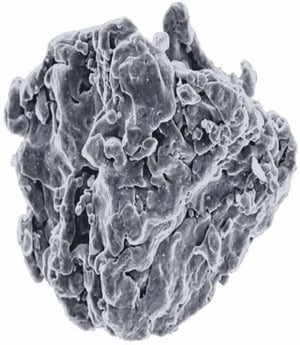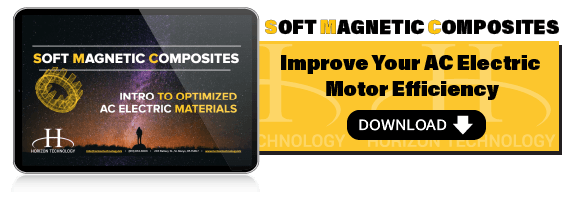In recent decades, trends in automotive and other industries have spiked demand for new magnetic materials. As a result, in the mid-1990s the very first components made from soft magnetic composite were born. And the trend of using these soft magnetic composites (SMCs) only continues to grow.
Those first SMC parts were ignition cores, used extensively in most GM vehicles. They were compacted round, and no insulating tape was used to protect the primary winding from the coil. Fast forward to today, and powder metal -- and SMC -- technology has come a long way. Keep reading to learn the basics of soft magnetic composites and what makes them so important to electromagnetic parts in multiple industries.
(Still need to brush up on the basics? Click here for powder metallurgy 101.)
Soft Magnetic Composite: The Basics

Once insulated, the powder is pre-mixed with compaction lubrication to smooth the way for compaction and ejection from the die. The lube gets removed during heat treating afterward.
Soft magnetic composites offer possibilities that simply didn’t exist before. With the right SMC material your technology can:
- Run faster
- Consume far less energy
- Become more compact & dense
- Achieve high permeability
- Use higher frequencies
- Experience lower core/eddy loss
Definition: Soft magnetic composites are ferromagnetic powder particles ideally coated with a uniform layer of electrical insulating film. SMC materials vary depending upon the final application.
Keep in mind that magnetic performance is a function of:
- Alloy system used
- Density of final part (saturation induction and permeability are influenced by density)
- Sintering temperature
- Carbon and nitrogen content after sintering
Soft magnetic composites are compacted just like any other powder metal part. Heated die compaction is often used to promote higher density. As noted earlier: Higher density = higher permeability = higher induction.
(Looking for more about SMCs? Check out our SMC resource page!)
Why SMCs Matter in Electric Motor Design
Powder metal magnetic materials can be classified as either sintered (for DC, or direct current applications) or soft magnetic composite types (for AC, or alternating current, applications).
The beauty of soft magnetic composites over sintered materials is that they’re designed with competitive magnetic properties, but with higher electrical resistivity. That resistivity is a big part of what makes SMCs appealing to those who are building low-loss parts, especially at high frequency.
Advantages of SMC materials reside in the shape-making capability of the powder. Shapes typically created through powder metal are easily achieved with soft magnetic powders. This enables 3-D flux carrying capabilities and round corners -- that’s right, complex, 3-D geometries can be done with efficiency.
You can even combine SMC with laminations or sintered parts. There are some electric motor applications out there for which only the tip is made from soft magnetic composite. Innovative designs are possible by combining the best parts of each part-making process.
What else does SMC allow for?
- Fewer necessary components
- Easy manufacturing of components
- Tight tolerances
- Smooth surfaces
- Savings on system level
- Compact winding
- Compact geometry
- Flux concentration
- Short flux path
- High iron fill factor
(Related Article: Soft Magnetic Composite FAQs)
The Heat Factor
As we discussed, SMC components use the shape-making skills of powdered metal, but the components aren’t sintered.
As such, they won’t have metallurgical bonds between powder particles. You’re instead relying on the strength of the interlocking particles plus the strength the insulating layer provides.Heat treating your soft magnetics can have an effect on magnetic performance. The point of heat treatment is twofold:
- Improve the soft magnetic properties (Relax the stresses)
- Improve mechanical properties
Heat treatment or curing is not sintering -- remember, no metallurgical bonds are formed. The higher the temperature, though, the better the strength of your SMC. Your components vendor should know the optimum temperature for resistivity and strength.
Step 2: Improve Your Electric Motor Design
Now you’ve got the basics on soft magnetic composites! The next step? Learning more about how you can incorporate it into your electromagnetic component design.
For example, SMC is ideal for many elements of the automobile -- especially the electric vehicle designs of the future and today. To see how powder metal materials can drive us all to better electric motor efficiency, check out the free e-book and related resources below:
Related Resources
- What Are the Best Materials for Electric Motor Design?
- WINTER 2020 COMPONENT SPOTLIGHT: Electrical Lamination + SMC Powder Metal Part
- Alternative to SMC: What Is Sintered Soft Magnetic Material?
(Editor's Note: This article was originally published in May 2018 and was recently updated.)




